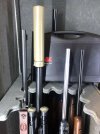My 12 year old filled 6 tags last fall. All shot with the same suppressed rifle. We didn't need additional hearing protection because of the can on his rifle (and mine, of course). Those 6 shots would have contributed to him having tinnitus like I suffer from 24 hours a day, but instead I am protecting him and his hearing. If only I had known then what we know now about hearing protection...
I got into silencers because I hate head mounted sound suppressive devices, over or in the ear. I have read a couple clinical trials that show in ear plugs reduce gunfire around 3-5 dB, that's all. Over the ear muffs prevent bone transmission of the sound, so they can be as effective as -20+dB; that's worth using, but not as much as a good can, which can measure as low as 115dB at the shooter's ear. Add the muffs on a covered range to the can and you have max protection. But muffs alone don't cover it.
I don't particularly like having a can on the end of my rifle (or pistol). I am not one to concern myself with the appearance of "tactical" or any other gibberish. I just like quiet guns because I can shoot and not contribute to hearing loss. I may be a man of extremes, who knows. But I do know that the benefits of suppressors far outweigh the costs to me, so I suppress most every gun I have, from 17 hornet to 12ga. I don't shoot every shot suppressed, as I love to shoot revolvers, but I don't shoot threaded muzzle guns without a can, or hardly ever. My one caveat is 50BMG. I haven't found a 50 can that tames the recoil enough to shoot a bolt action suppressed; that combo takes me past my limit quickly.
Your mileage will vary. Find a dealer who lets you test fire a few. He/she can get you going in the right direction. I focus on materials of the can first, especially in rimfire, because of cleaning. Then what it will be used on. Then how it mounts. In that order. For centerfire, I may swap the criteria by what to use it on, how it mounts, then materials (weight, durability).

